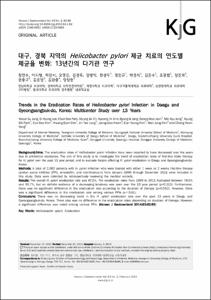KUMEL Repository
1. Journal Papers (연구논문)
1. School of Medicine (의과대학)
Dept. of Internal Medicine (내과학)
대구, 경북 지역의 Helicobacter pylori 제균 치료의 연도별 제균율 변화: 13년간의 다기관 연구
- Keimyung Author(s)
- Park, Kyung Sik; Kim, Eun Soo; Cho, Kwang Bum
- Department
- Dept. of Internal Medicine (내과학)
- Journal Title
- Korean Journal of Gastroenterology
- Issued Date
- 2014
- Volume
- 63
- Issue
- 2
- Keyword
- Helicobacter pylori; Eradication
- Abstract
- Background/Aims: The eradication rates of Helicobacter pylori infection have been reported to have decreased over the years due to antibiotics resistance. The aim of this study is to investigate the trend of eradication rates of first-line triple therapy for H. pylori over the past 13 year period, and to evaluate factors affecting H. pylori eradication in Daegu and Gyeongsangbuk-do, Korea. Methods: A total of 2,982 patients with H. pylori infection who were treated with either 1 week or 2 weeks first-line therapy (proton pump inhibitor [PPI], amoxicillin, and clarithromycin) from January 1999 through December 2011 were included in this study. Data were collected by retrospectively reviewing the medical records. Results: The overall H. pylori eradication rate was 87.2%. The eradication rates from 1999 to 2011 fluctuated between 78.0% and 95.7%, but no definite evidence of a decreasing tendency was seen over the 13 year period (p=0.113). Furthermore, there was no significant difference in the eradication rate according to the duration of therapy (p=0.592). However, there was a significant difference in the eradication rate among various PPIs (p<0.01). Conclusions: There was no decreasing trend in the H. pylori eradication rate over the past 13 years in Daegu and Gyeongsangbuk-do, Korea. There also was no difference in the eradication rates depending on duration of therapy. However, a significant difference was noted among various PPIs.
- Alternative Title
- Trends in the Eradication Rates of Helicobacter pylori Infection in Daegu and Gyeongsangbuk-do, Korea: Multicenter Study over 13 Years
- Publisher
- School of Medicine
- Citation
- 정연수 et al. (2014). 대구, 경북 지역의 Helicobacter pylori 제균 치료의 연도별 제균율 변화: 13년간의 다기관 연구. Korean Journal of Gastroenterology, 63(2), 82–89. doi: 10.4166/kjg.2014.63.2.82
- Type
- Article
- ISSN
- 1598-9992
- Appears in Collections:
- 1. School of Medicine (의과대학) > Dept. of Internal Medicine (내과학)
- 파일 목록
-
-
Download
 oak-aaa-03334.pdf
기타 데이터 / 397.17 kB / Adobe PDF
oak-aaa-03334.pdf
기타 데이터 / 397.17 kB / Adobe PDF
-
Items in Repository are protected by copyright, with all rights reserved, unless otherwise indicated.